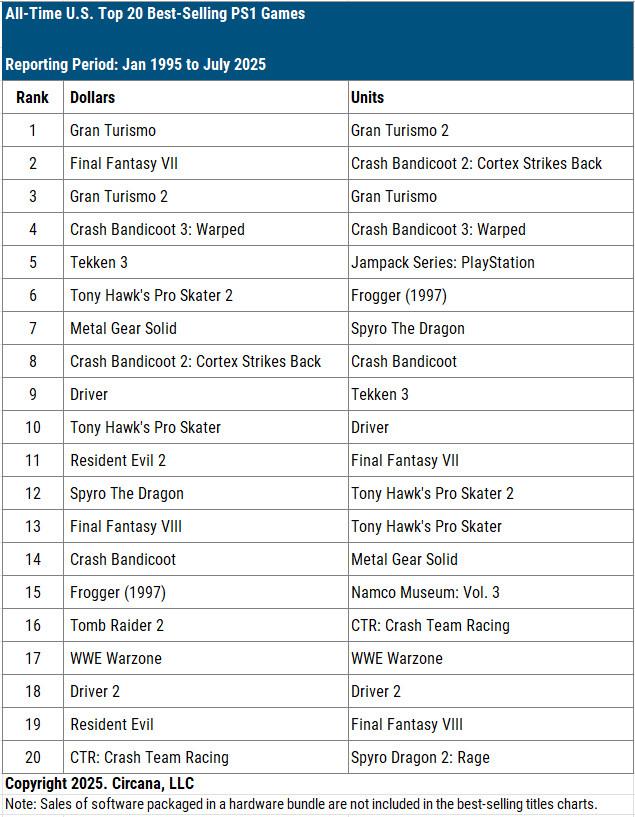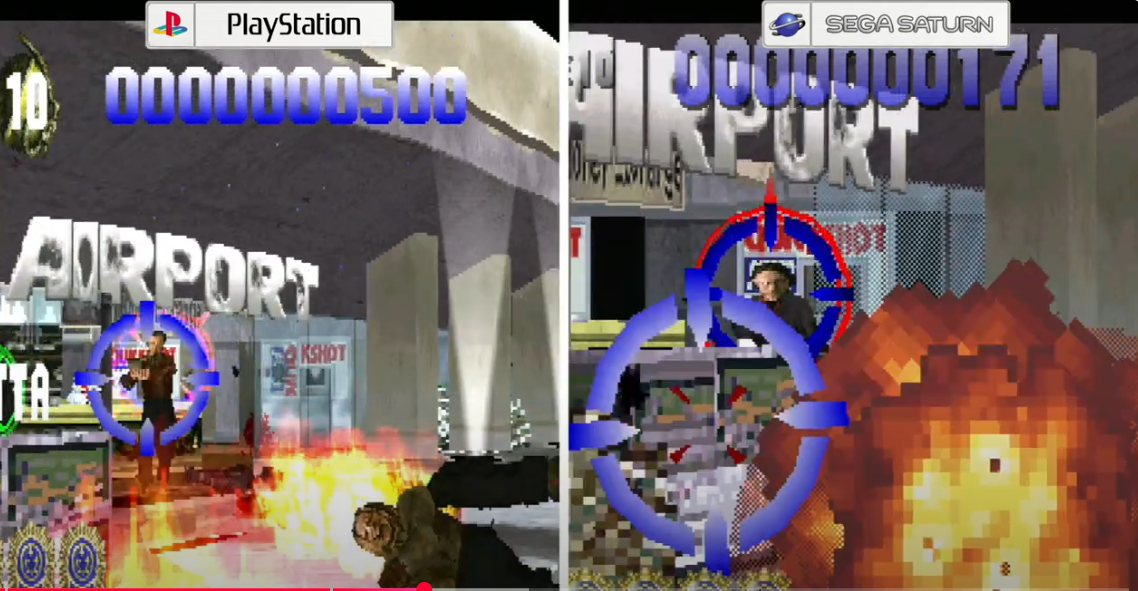I think a problem Sega had was they had such smash hit arcade roots, a lot of their home games were just downports with hardly any extra features. A big Sega arcade gamer probably loved it, but gamers looking for more meat or something new and longer lasting appeal they picked PS1 or N64.
I always found it odd out of Sega, Nintendo and Sony that Sega struggled the most with hardware. You'd think with their arcade roots making awesome machines that their R&D tech wizards should figure out how to make solid home console hardware, which Nintendo/Sony shouldnt be able to figure out or beat them at it.
Well there is some nuance here to consider. SEGA always planned for Saturn to have 3D at least on Model 1 level, because the VDP1 was always part of the GigaDrive design, and the VDP1 always had operations for distorted sprites that a 2D-only system would not have bothered including. But that's probably also what led them to choose the forward texture mapping approach that chip used, since it'd be "good enough" for 3D and solid approach for 2D graphics as well.
But I'm thinking at some point (before PlayStation was revealed publicly), SEGA got to adding VDP2 to the system design as well. I'm not totally clear on the timelines for that or what features were added pre or post-PlayStation reveal. For sure the 2nd SH2 was added in response to PS1, but the myth SEGA only added 3D following December 1993 is completely false: 3D was always there for Saturn from 1992 onward.
The thing with SEGA's arcade systems is, those teams used A
LOT of chips in parallelized processing setups, to achieve the performance they hit. The Model 1 was something like $15K to purchase back when new; I'm sure actual BOM costs were lower but the R&D spent on the chipset's graphics renderer and other custom chips was probably quite hefty. And the costs for Model 2 need no introduction.
I think SEGA felt that type of 3D is what home gamers would've expected, and assumed that they wouldn't be able to shrink it all down into a cost-effective home console with a simple chipset (i.e no dual CPU setup) by late 1994. So even if GigaDrive/Saturn was at first planning to feature a modest 3D capability i.e pared-down Model 1 with texture mapping support (further evidence of this is that SEGA were considering an NEC CPU; the Model 1 uses a NEC V60 for its CPU), they were always going to also push 2D with that design too.
Honestly, SEGA rushing a redesign after December '93 to compete with PS1's theoretical specs really screwed over what was an otherwise rather clean and simple Saturn design. It also seemingly pushed them into adding a second SH-2 (actually, it'd seem the 2nd SH-2 might've been considered & added prior to PS1's official public reveal), which made them shelve finishing the SCU DSP. I think a Saturn with 1x SH-2, a somewhat better VDP1, simplified VDP2, finished SCU DSP, and some local work RAM for the SCU DSP would've been very capable in its own right in the long run, if SEGA got the APIs and dev libraries really good up to launch, and provided more comprehensive documentation.
Saturn was capable of 3d games but 3d was harder to develop for Saturn. Saturn is excellent when it comes to 2d. For example , Marvel versus capcom or marvel versus street fighter on Saturn was better than Ps1 but RE1 on Ps1 performance is better than Saturn version.
TBF, the Saturn version of RE1 isn't done by Capcom, but Tose. So there may've been budget and time constraint reasons why it didn't look or run as well as it could've.
All you need to know about why the Saturn failed is Sega thinking Atari Jaguar was going to be a threat to their business. Purely clueless management.
In hindsight the idea of anyone talking '90s Atari seriously seems laughable, but you have to remember at that time, they were still a company with some brand recognition and able to pull some big deals. They got IBM to manufacture the Jaguar for example; no small-name random would've been able to arrange such a deal.
The Saturn was doomed from the design phase and not taking Sony seriously. The disconnect between Japan and America can't be ignored. The overinflated success of the Genesis in North America. Europe was the lone bright spot. The Sega CD and the 32X, so many things before the Saturn was even completed.
Also TBF, I think it's wrong to say SEGA didn't "take Sony seriously", when no one really knew what the PlayStation was until sometime in mid/late '93. And right after Sony revealing those specs, SEGA took them so seriously they forced their engineers to redesign the Saturn in record time without delaying the system launch. If you're going to basically screw up your own system design in reaction to a competitor's theoretical specs, I'd say you maybe took them
TOO seriously.
I do agree tho that the inflated success of Genesis in NA probably contributed to some fatal mistakes around Saturn, namely the 32X. That only got approved because Nakayama thought Genesis was doing well enough in America to justify a new upgrade to combat Jaguar and 3DO. Had they known the financial situation was as bad as it was, I think he would've immediately cancelled approval of the 32X and just gotten America in line to support Saturn earlier & more significantly.
That maybe would've even helped save the Saturn in America.
Saturn was dead somewhere between the Japan launch to the $299 mic drop moment, and it just got worse. If you believe articles out there, 50% of their sales numbers were either returned or sitting on shelves and not actually sold. It's very similar to the Genesis where they counted many unsold consoles sitting in warehouses that had been returned from retailers.
Well, you can't believe all the articles out there because many are sensationalist. The $299 moment was at the first E3, which wasn't televised and most non-gaming outlets didn't care to mention it. There was barely any internet audience at the time as well (certainly not the way it is today); at best you had some Usenet groups on CompuServe forums and BBS going apeshit about it but they were incredibly niche.
Basically, the $299 moment didn't do or mean much to customers, but it did catch the eyes of retailers, who were present at that E3. But that's on the business side of things and would've been behind closed doors, so far as deeper reactions or moves made thereafter. What actually doomed Saturn in America wasn't the $299 IMO, but the surprise May launch.
That May launch destroyed goodwill with many retailers, with some just refusing to stock the Saturn whatsoever. The price was super-high but could've worked if available software was consistent enough to justify. It wasn't, so a limited number of units were sold between the May launch and originally planned September release. It also completely threw off SEGA's advertising partners, because they couldn't roll out the typical ad campaign since a lot of the ads weren't finished, or were already schedules for a September time period.
As someone else mention as I did in another thread, they used the System 32 arcade board as the initial design and regretted not using the Model 1 or similar set-up.
This isn't true; the GigaDrive concept used both System 32 and Model 1 as inspiration for the initial design. Go look at the VDP1's development history and the way it was specifically designed to work with distorted sprites in particular. That alone is indication it was a hybrid of System 32 and Model 1 graphics principles, although probably leaning more towards the former in practice.
If you believe the talk that Saturn only added 3D after the PS1 reveal, then that talk's misled you. SEGA did beef up Saturn in reaction to PS1, yes, but that was was mainly in computational power, not graphics chipsets or features. VDP2 probably did get some extra features in response to PS1, but VDP1 didn't. VDP1 was always there in the design since the GigaDrive days. They had already decided on (a) SH-2 by late 1992 and added the 2nd one by late 1993.
I'm still not convinced the Saturn was any better than either the PS1 or N64 at 2D graphics. What exactly made it better? In most cases where the Saturn beats the PS1 at multiplatform ports, it's the extra RAM carts that make the difference, not the internal vanilla hardware. In all other cases there's no definite winner. Some games are better on the Saturn, some are better on the PS1. Both consoles have some equally great looking 2D exclusives too. I just don't think there's a single game on either console that proves one is superior to the other on that front. They look equally good to me.
Just because the Saturn was weaker in 3D than it's competition it doesn't automatically make it better at 2D. I'ts not an RPG where a weak stat makes other stats stronger.
Actually, there are some very specific areas in the vanilla hardware where Saturn is better for 2D than PS1:
1: The CD-ROM cache buffer. It's 512 KB in Saturn, but only 32 KB in PS1. So, less slow CD drive accesses to make for sprite graphics data, when talking about Saturn
2: Low-latency large off-chip VRAM. For Saturn it's 512 KB of SDRAM with 17 ns latency. In the PS1 it's 1 MB of VRAM for both the textures and framebuffers, but 60 ns access latency (before they switched to SGRAM). Also for PS1, it's a 16-bit device; I think it's also 16-bit for the 512 KB texture SDRAM in Saturn as well but again, much lower latency.
3: More VRAM in general. 1.5 MB for Saturn (VDP1: 512 KB texture RAM, 2x 256 KB framebuffer RAMs; VDP2: 1x 512 KB texture cache (VDP2 doesn't use a framebuffer; it uses internal line buffer memory and scanline rendering like 4th-gen consoles (well, I dunno if 4th-gen consoles used line buffer memory the way I'm picturing it, vs. just completely hardware-based sprite and tile registers that sent output in time with commands synced to the scanline beam refresh rate)) vs. 1 MB in PS1 (shared between textures and framebuffers; much higher latency).
PS1 does have a 2 KB direct-mapped embedded texture cache, but for 2D games in particular the combination generally isn't as good as what Saturn offers with a fat 512 KB off-chip low-latency SDRAM texture cache that can be accessed at random directly.
So, those are the three big reasons why Saturn in general would've had better-looking 2D games vs. PS1. There are some other things too, like how with PS1 you aren't literally using sprites (well, Saturn isn't "literally" using sprites either, at least not hardware-based ones like the SNES or Genesis did), but mapping textures to paired triangles forming quads, so the more "sprites" you have, the less polys you have for things like the backgrounds (also have to be mapped to polys) and 3D graphical effects. A single quad being equal to two triangles does have some advantages when it comes to needing less polygons for similar things.
Not to mention, Saturn has VDP2 for stuff like background art, scrolling backgrounds, and Mode 7-style 3D planes. All things which on PS1, you'd need to dedicate triangle budget towards. And this is all before taking into consideration the 1 MB ROM, 1 MB RAM, and 4 MB RAM Expansion cartridges some 2D Saturn games used.









